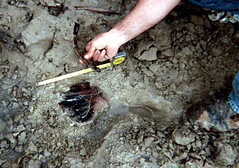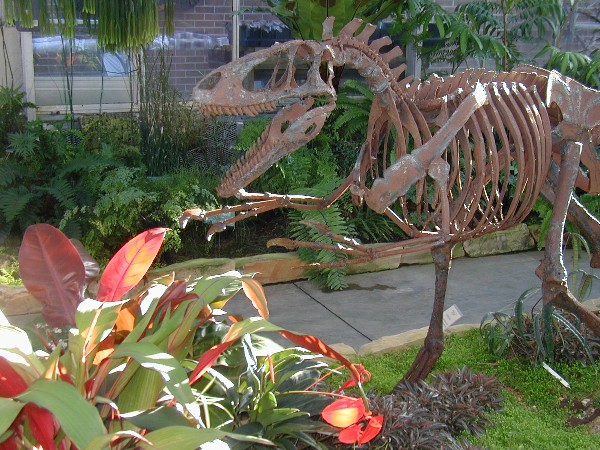 Greg McDonald is here cataloging Megalonyx bones from the site. He found a right fifth metacarpal of a Paramylodon harlani that we had misidentified as a Megalonyx metatarsal. This is the first confirmed record of a Paramylodon in Iowa.
Greg McDonald is here cataloging Megalonyx bones from the site. He found a right fifth metacarpal of a Paramylodon harlani that we had misidentified as a Megalonyx metatarsal. This is the first confirmed record of a Paramylodon in Iowa.
Author Archives: David
New dig photos
Dig success!
Greg McDonald speaking
Mark your calendars for Thursday, May 7.  Dr. Greg McDonald, Senior Curator of Paleontology for the National Park Service, renowned giant ground sloth expert, and consultant on the Tarkio Valley Sloth Project, will offer a lecture: The Museum and the Megalonyx: A History of Great Aspirations and Sloths in Iowa, at 7:00 PM in the Macbride Hall Auditorium on the University of Iowa campus. Meet Greg at a public reception before the lecture, from 6:00-7:00 PM, in the Iowa Hall gallery of the Museum of Natural History, Macbride Hall. Greg is an excellent speaker and a real sloth enthusiast. It will be an interesting and entertaining evening.
Dr. Greg McDonald, Senior Curator of Paleontology for the National Park Service, renowned giant ground sloth expert, and consultant on the Tarkio Valley Sloth Project, will offer a lecture: The Museum and the Megalonyx: A History of Great Aspirations and Sloths in Iowa, at 7:00 PM in the Macbride Hall Auditorium on the University of Iowa campus. Meet Greg at a public reception before the lecture, from 6:00-7:00 PM, in the Iowa Hall gallery of the Museum of Natural History, Macbride Hall. Greg is an excellent speaker and a real sloth enthusiast. It will be an interesting and entertaining evening.
McDonald’s lecture kicks off a year-long celebration of the 150th anniversary of the Museum of Natural History, the oldest museum in Iowa. Check the museum’s web site http://www.uiowa.edu/~nathist/ for details of other upcoming events. acheter aldactone
A clam-tastic find!
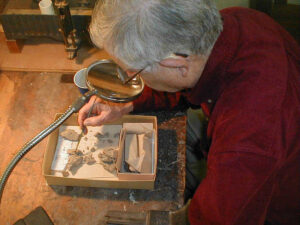 The dead of winter gives us the opportunity to catch up on our lab work. Holmes has been exploring a sample of clay we collected two years ago near the juveniles, and he found some clams inside! These are the first fossil mollusks we’ve seen in the clay. Jim Theler at the University of Wisconsin–La Crosse has identified them as members of the Sphaeriidae family which has two common genera Pisidium or pill clams and Sphaerium or fingernail clams.
The dead of winter gives us the opportunity to catch up on our lab work. Holmes has been exploring a sample of clay we collected two years ago near the juveniles, and he found some clams inside! These are the first fossil mollusks we’ve seen in the clay. Jim Theler at the University of Wisconsin–La Crosse has identified them as members of the Sphaeriidae family which has two common genera Pisidium or pill clams and Sphaerium or fingernail clams.
A sloth garden for Marion
The city of Marion is soliciting ideas from local residents and other interested parties for improving city life and strengthening its identity in a program they are calling Imagine8. I’ve been working with a group of friends and supporters of the Eastern Iowa Paleontology Project (EIPP) to develop a statement encouraging an initiative to improve natural science education in the city. We all agree it would be very nice if we can create a permanent home for our dinosaur in the process, but more important is encouraging science education. You would think with the shortage of engineers, scientists, doctors and other health professionals in this country and our pressing environmental needs that there would be more support for teachers and families wanting to encourage their children in this direction but science funding always trails far behind that for culture and the arts. Since Cedar Rapids hasn’t called me yet about redeveloping their flooded downtown area into an Ice Age Sloth Park , I’m planning to dust off the idea for Marion and propose it as part of a general botanical center.
Official report: last dig and preparation
Since we started excavating in 2003, Holmes has been keeping an official log he calls Megalonyx Matters documenting our significant activites. This is publication #17, covering the preparation work leading up to our last expedition and its results. Lest anyone be concerned, the stubborn beaver discussed below is alive and well, and continuing to safeguard the site with a cover of at least a foot of water . . . . Dave
Megalonyx Matters 17: Site preparation (Aug. 27, Oct. 3, Dec. 4) and excavation (Dec. 6)
Site Preparation
On August 27, 2008 Dave Brenzel, Holmes Semken, Phil Mather (Mather and Sons) and Bob Athen (landowner) met at the site and devised a plan to extend the sloth excavation about 30 feet into the south bank to search for more juvenile remains. The first obstacle proved to be a downstream beaver dam that substantially increased the water level over the bone-bearing, blue-grey clay. Bob had experimented with removing the dam by hand. This worked but the beavers repaired it overnight. It was clear that each excavation would be initiated by attacking the dam.
On October 3, Holmes and Dave returned to oversee the Mather’s levee repair and overburden removal. Dave waded in and breached the beaver dam by the time the excavator arrived (8:00 am); the water dropped 2.5 feet at the site. We were delighted because this exposed the bone-bearing matrix. Phil (name of operator), who operated the excavator, got the machine to streamside (and back out) via some creative road repair over very mucky terrain resulting from the infamous 2008 flood. By the end of the day there was a combination dam/entrance ramp both up and downstream from the future excavation area. The ramps were about 30 feet apart. The old lateral (midstream) levee was largely removed by flooding but it was traceable and was also reinforced by the excavator. Sloth bone, predicted to be under this levee, appeared safe. At the end of the day, the south bank was pulled back about 30 feet and the dig floor appeared accessible for a crawler to enter, clear remaining overburden (approximately one foot) and build a stream side levee to protect south bank excavations. Phil noted, “We now have a big hole to play in on the next dig.”
The crawler, operated by Will Mott, arrived December 4. Dave drove to Shenandoah a day early to reopen negotiations with the resident beaver. Will started clearing overburden by 9:30 AM and worked until nightfall. Dave and Will both noted the clay was more varied in color and, except for an occasional patch, less blue than previously seen. There was also a distinct up-tilt in the clay layer upstream (East). In the afternoon, after the bulk of the overburden had been moved, Will attached a blade he had fabricated to the bucket of the crawler and began shaving off thin layers of clay to reduce the amount the weekend recruits would have to remove. Dave stood by watching for traces of bone. At the end of the day Will used the bucket to dig a sump to collect melt water and satisfy Dave’s curiosity about the depth of the clay. He dug through approximately four feet of clay, all as homogenous as the surface layers, before striking a layer of fine white sand. The sand began to seep into the hole from the sides under the pressure of a slow flow of water that eventually filled the hole (so much for the sump idea). Dave and Will left the site by 6PM.
Excavation
The Sloth Rapid Response Team journeyed to Shenandoah on Friday, Dec. 5th and they were on site at 8:00 Saturday morning. After bailing out the hole, and starting the pumps to keep up with Dave’s spring, the volunteers formed a line facing the stream side levee and began cutting a trench toward the south bank of the cut parallel to the levee. Spoil was thrown onto the levee. By the end of the day the area, except for a snapping turtle bone, proved barren.
While disappointing in terms of sloth bone recovery, the dig did define the south boundary of the bone scatter. This boundary is now defined to the north and east as well as to the south. Bone has been probed in the partly excavated intermediate areas where the juvenile bone has been concentrated. Another positive note: Ron Vogel performed a feasibility test on the clay using ultrasonic equipment he borrowed from his department. The results were promising and Ron hopes to construct a prototype of an ultrasonic bone detector in time for our next venture to the site. The next dig will occur after the spoil that forms the south levee is pushed back into the south excavation and a new levee created between the two entrance ramps. The crawler will again be required and we are working on ways to facilitate its access and egress.
Participants on the December 6, 2008 dig: Lynn Alex (OSA), Bob Athen (landowner), Cyril Below (grandson of Herb Dircks), David Brenzel (Co-PI, NSF grant), Andy Clack (Ancient DNA Centre, McMasters University), Herb Dircks (UI Rapid Prototyping Laboratory), Harold Decuir (President, Board of Directors, Greater Shenandoah Historical Museum, Kandyce Decuir (daughter), Pete Eyheralde (Naturalist, Mahaska County Conservation Board) , Elizabeth Fox (OSA), Cherie Haury-Artz (OSA), Sarah Horgen (UI Museum Natural History), Don Johnson UI Hospitals and Clinics, aka the Fossil Guy, and President, Eastern Iowa Paleontology Project, Meghann Mahoney (Museum of Natural History student-staff, Anthropology Major), Robert McAfee, Ph.D. (Faculty, Doane College), Holmes Semken (UI-Geoscience, Emeritus; PI, NSF grant), Austyn Slaybaugh CR High School student), Jennifer Sweet (OSA), Ron Vogel UI-Dept.of Physics and Astronomy), and Mary Weber (OSA).
Holmes A. Semken, Jr and David J. Brenzel, January 5, 2009
Ultrasound test-results
 Ron Vogel, sloth volunteer and resident physics expert, has the theory that the remarkable uniformity of the clay that the sloth bones are resting in provides a unique opportunity to use ultrasound technology to search underground. If so it would save us a lot of time and money digging blindly for bones, and allow us to extend our search area significantly. Preliminary results are back from the clay samples he collected at the site last month and the results are promising.
Ron Vogel, sloth volunteer and resident physics expert, has the theory that the remarkable uniformity of the clay that the sloth bones are resting in provides a unique opportunity to use ultrasound technology to search underground. If so it would save us a lot of time and money digging blindly for bones, and allow us to extend our search area significantly. Preliminary results are back from the clay samples he collected at the site last month and the results are promising.
According to Ron, “The results are. . . the same as I found in the tests on site. That is, the acoustic loss is about 5 to 10 times that of the human body. That seems like a lot but it is actually a lot less than anyone else has reported for soil. Based on these measurements, I’m working on a device we can use on site.” He doesn’t know if he can get it done in time to do us any good but plans to try.
 Ground-penetrating radar, which uses radio wave frequencies, is generally used for remote underground sensing, but it won’t work at the site under our conditions–the wet clay absorbs too much of the signal. Ultrasound works similarly, but uses sound waves instead, and doesn’t suffer from the attentuation loss-problem under wet conditions. The technology runs into problems however with sorting out the meaning of the many different signal returns that result from trying it in mixed materials. For that reason ultrasound is limited to looking inside relatively uniform materials– like concrete roadways and bridges (for corrosion), or steel railroad tracks (for signs of fatigue or cracks) and of course people (for babies). More, as Ron moves ahead. . . . Dave
Ground-penetrating radar, which uses radio wave frequencies, is generally used for remote underground sensing, but it won’t work at the site under our conditions–the wet clay absorbs too much of the signal. Ultrasound works similarly, but uses sound waves instead, and doesn’t suffer from the attentuation loss-problem under wet conditions. The technology runs into problems however with sorting out the meaning of the many different signal returns that result from trying it in mixed materials. For that reason ultrasound is limited to looking inside relatively uniform materials– like concrete roadways and bridges (for corrosion), or steel railroad tracks (for signs of fatigue or cracks) and of course people (for babies). More, as Ron moves ahead. . . . Dave
Photos, December 6, 2008 dig
Participating in the dig: Lynn Alex, Bob Athen, Cyril Below, David Brenzel, Andy Clack, Harold Decuir, Kandyce Decuir, Herb Dircks, Pete Eyheralde, Elizabeth Fox, Cherie Haury-Artz, Sarah Horgen, Don Johnson, Meghann Mahoney, Robert McAfee, Holmes Semken, Austyn Slaybaugh, Jennifer Sweet, Ron Vogel, and Mary Weber. Thanks all for another fun and successful outing. . . . Dave
Sloth music
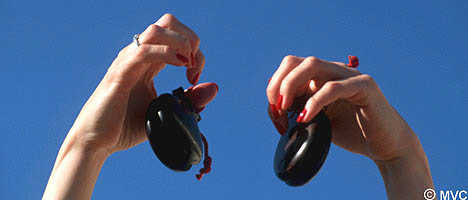 We’re like Goldilocks wandering around in the cottage of The 3 Sloths—the table is set, the beds are made and the TV is on—maybe the owners are out in back . . . but we’re pretending they’re gone forever and we’re in control now. Look around—sloths may be extinct, but they aren’t dead! We’re surrounded by signs of their lingering presence, and the continuing performance of many of their Ice Age co-stars. Applaud Blue Jays today for our oak trees. Admire the Osage Orange that still grows a formidable sloth defense. And grieve for the lonely Honeylocust that still cries out every fall for the sloths to return. (photo borrowed from)
We’re like Goldilocks wandering around in the cottage of The 3 Sloths—the table is set, the beds are made and the TV is on—maybe the owners are out in back . . . but we’re pretending they’re gone forever and we’re in control now. Look around—sloths may be extinct, but they aren’t dead! We’re surrounded by signs of their lingering presence, and the continuing performance of many of their Ice Age co-stars. Applaud Blue Jays today for our oak trees. Admire the Osage Orange that still grows a formidable sloth defense. And grieve for the lonely Honeylocust that still cries out every fall for the sloths to return. (photo borrowed from)
Picky eaters shouldn’t be surprised when they go extinct
 Fussy birds get what they deserve—that’s how some ornithologists explain the demise of birds like the Ivory-billed Woodpecker (Campephillus principalis) (Shugart, 2004). Ivory-bills foraged for insects by prying up the bark of large trees, leaving it to other woodpeckers to probe the deeper reaches. There’s a limited supply of suitably-clad trees so the birds needed large territories—at least 36 miles2 by one account (ibid.). Under this scenario agricultural land-clearing and hunting were just the final nails-in-the-coffin. One might be skeptical of explanations of extinction that blame the victim for choosing an unreliable niche. Trees die for many reasons–senescence, lightning, disease, over-browsing, floods, droughts, ice, wind-throw . . . all contributing to the dynamic patchwork that characterizes a healthy diverse woodland. The birds wouldn’t have evolved their habits if they didn’t have a reliable food-supply for millions of years and the behavioral elasticity to take advantage of the opportunities that arose and
Fussy birds get what they deserve—that’s how some ornithologists explain the demise of birds like the Ivory-billed Woodpecker (Campephillus principalis) (Shugart, 2004). Ivory-bills foraged for insects by prying up the bark of large trees, leaving it to other woodpeckers to probe the deeper reaches. There’s a limited supply of suitably-clad trees so the birds needed large territories—at least 36 miles2 by one account (ibid.). Under this scenario agricultural land-clearing and hunting were just the final nails-in-the-coffin. One might be skeptical of explanations of extinction that blame the victim for choosing an unreliable niche. Trees die for many reasons–senescence, lightning, disease, over-browsing, floods, droughts, ice, wind-throw . . . all contributing to the dynamic patchwork that characterizes a healthy diverse woodland. The birds wouldn’t have evolved their habits if they didn’t have a reliable food-supply for millions of years and the behavioral elasticity to take advantage of the opportunities that arose and 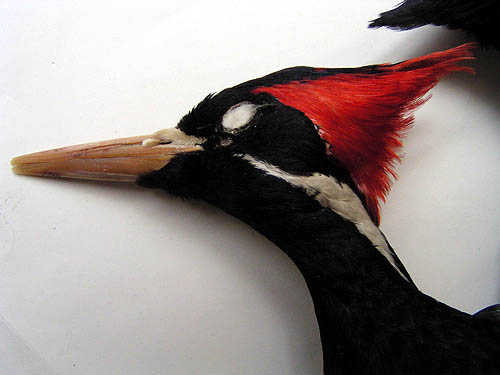 overcome challenges. Something significant altered the woodland disturbance regime. In that gap, and missing from the list above may reside an ice age ghost–keystone mega-herbivores that played a critical role in ancient forests–as the giants do today wherever they have survived (Owen-Smith, 1987). (picky eater photo borrowed from, woodpecker photo borrowed from)
overcome challenges. Something significant altered the woodland disturbance regime. In that gap, and missing from the list above may reside an ice age ghost–keystone mega-herbivores that played a critical role in ancient forests–as the giants do today wherever they have survived (Owen-Smith, 1987). (picky eater photo borrowed from, woodpecker photo borrowed from)
A follow-up story in the paper
A lot of interest in the project in southwest Iowa. Here’s another story in the local paper:
http://www.southwestiowanews.com/site/news.cfm?newsid=20217734&BRD=2703&PAG=461&dept_id=555139&rfi=6
The reporter, Tess Gruber Nelson, visited the site Saturday and called for an update Monday morning. KMA, the local radio station, called to do an interview too. Thanks again to everyone who participated and made it so memorable. Dave

